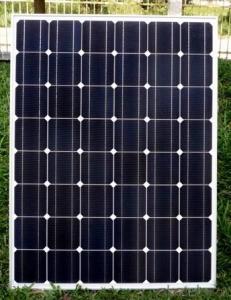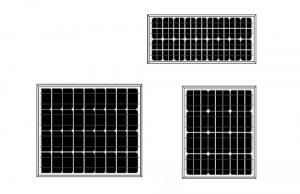Brown Solar Panels - CNBM Poly 250W Solar Panel with TUV UL CE Certificate for Residential
- Loading Port:
- Shanghai
- Payment Terms:
- TT OR LC
- Min Order Qty:
- 100 watt
- Supply Capability:
- 1000 watt/month
OKorder Service Pledge
OKorder Financial Service
You Might Also Like
Specification
CNBM Poly 250W Solar Panel with TUV UL CE Certificate For Residential
Introduction
Electrical connections are made in series to achieve a desired output voltage and/or in parallel to provide a desired current capability. The conducting wires that take the current off the modules may contain silver, copper or other non-magnetic conductive [transition metals]. The cells must be connected electrically to one another and to the rest of the system. Externally, popular terrestrial usage photovoltaic modules use MC3 (older) or MC4 connectors to facilitate easy weatherproof connections to the rest of the system.
Each module is rated by its DC output power under standard test conditions, and typically ranges from 100 to 365 watts. The efficiency of a module determines the area of a module given the same rated output – an 8% efficient 230 watt module will have twice the area of a 16% efficient 230 watt module. There are a few solar panels available that are exceeding 19% efficiency. A single solar module can produce only a limited amount of power; most installations contain multiple modules. A photovoltaic system typically includes a panel or an array of solar modules, a solar inverter, and sometimes a battery and/or solar tracker and interconnection wiring.
The photovoltaic effect was experimentally demonstrated first by French physicist Edmond Becquerel. In 1839, at age 19, he built the world's first photovoltaic cell in his father's laboratory. Willoughby Smith first described the "Effect of Light on Selenium during the passage of an Electric Current" in a 20 February 1873 issue of Nature. In 1883 Charles Fritts built the first solid statephotovoltaic cell by coating the semiconductor selenium with a thin layer of gold to form the junctions; the device was only around 1% efficient.Micro-inverted solar panels are wired in parallel which produces more output than normal panels which are wired in series with the output of the series determined by the lowest performing panel (this is known as the "Christmas light effect"). Micro-inverters work independently so each panel contributes its maximum possible output given the available sunlight.[6

Suggested application
Home lighting business lighting,
Garden lighting, pavement lighting
Farmer household lighting
Decorative water pump
Traffic signal lighting
Industry area
Business area
Solar Power Plant
Product feature
Modules are made of Monocrystalline or Polycrystalline Silicon cell.
Materials and color of the solar panel frame: Clear anodized aluminum alloy type 6063T5 Universal frame; Silver-white color;
The output connection gathers the coupling: Selects conforms to the IEC-612615; 2005, class II, IEC61730 international standard; Airtight waterproofing binding clamp;
Module seal structure: The surface is thick, the high diaphanous rate armored glass with solar cell board special-purpose 3.2mm becomes after the high temperature lamination craft. The back selects has waterproof and anti- aged performance fine TPT materials. The entire block battery board has, the waterproofing, the anti- aging airtight and so on the fine performance;
Power tolerance: +/-3%
Packaging
International standard cartons (according to the requirements of customers)
- Q: Can solar panels be used in areas with high levels of wildlife activity?
- Yes, solar panels can be used in areas with high levels of wildlife activity. However, it is important to take certain precautions to minimize potential impacts on wildlife. This can include implementing proper installation techniques, such as avoiding nesting sites or wildlife corridors, and using deterrents to prevent wildlife from damaging the panels. Additionally, incorporating habitat-friendly designs and partnering with local conservation organizations can help mitigate any potential negative effects on wildlife populations.
- Q: My mom's house has some solar power panels on the top of her house but they are not connected to anything. They don't even have wires or anything like that. Does anyone know how to connect and make solar panels work? Thank You
- It sounds like you nor anyone at your home knows enough about solar to be able to hook them up no matter what type they are. I have to agree with others that they could be hooked up and you just can't see the connections. So the best thing for you to do is get a contractor to come out and check them out. It don't have to be a Solar Dealer because I am a dealer and I use electrical contractors to do the installs. A solar dealer is not always legal to install and normally do like I do and just design and sell the systems. However most any dealer can easly install a solar power system because they are trained just not legal to do the work. Having someone other then an electrician work on it could void the warranties.
- Q: How do solar panels affect home insurance rates?
- Solar panels can potentially have a positive impact on home insurance rates. While the initial cost of installation may increase the overall value of a home, insurance companies often offer discounts or special policies for homes equipped with solar panels due to their reduced reliance on traditional energy sources and increased energy efficiency. However, it is recommended to consult with insurance providers to determine the specific impact on rates as it may vary depending on the location, type of system, and other factors.
- Q: Could anybody give some review about Homemade Solar Panel.
- If you want to make hot water then they are easy to make. Search the web.
- Q: Can solar panels be installed on military bases or installations?
- Yes, solar panels can be installed on military bases or installations. In fact, many military bases around the world have already incorporated solar energy as a part of their sustainability initiatives. Installing solar panels on military bases not only helps reduce their reliance on traditional energy sources but also enhances their energy security and resilience.
- Q: where can i get some solar panels for a camper trailer
- Homemade okorder /
- Q: I am doing a big project for school, and I have decided to do it on solar panels. I am new to the subject but have done some research on it; I would like to buy a single panel, a charge controller, an inverter and a battery, to charge a simple lamp. My question is if the items in the links will work together and if the panel will produce electricity?
- Sounds like fun. A -watt panel doesn't need a charge controller, though. In fact, it may take more than watt to power the charge controller. With a low-wattage panel, you can just connect the panel directly to the battery. A 7 amp-hour gel cell (the kind used in burglar alarms) would be good for this purpose. The panel is too small to charge a car battery. The gel cell should power that inverter, but only for a few minutes. If you want to be more impressive, look for a low power, 2-volt device. An iPod plus a 2-volt car adapter would be an example.
- Q: How much does 000 square feet of solar panels cost? This is for a pool with dimensions 75ft by 25ft? How much will it cost including installation fee and the water heater?
- My Father-in-Law had around 300sqft of solar panels installed for the equivalent of around ?3000 or $5000. These were just the cheap and relatively inefficient black plastic tubes that were installed on his roof. This was in South Africa where the labour rates are quite cheap. The system works okay and heats a 40ft x 20ft outdoor pool to over 30C in the height of summer. Rather than a pool heater, I think it might be good to look at an air source heat pump to help heat the water in Autumn/Winter when you don't get enough sun to heat the pool. These will be expensive (over $5000), but they will use less than 30% of the electricity of a standard electric water heater. Just the solar panels could cost you $5-20K including fitting.
- Q: Can I use a regulator from a car to regulate the voltage from a solar panel to a battery?
- solar panels will naturally produce a certain DC voltage which is what your battery needs - the current will vary based on the sun light. You need probably 4V to have some over voltage. So based on your specs look at having at least 4 V but not too much over that (tells you how many panels you need in series) I would have blocking diodes (probably the solar cell has them built in) to insure the battery does not discharge thru the panel.
- Q: How do you know when it is a good deal to buy a solar panel. For example, what is a good cost per watt, how many volts should I expect, etc.
- Both might be bigger. When it is cloudy and little solar (iciness) you'll have a breeze. When it is nonetheless and sunny, you could have the solar. When the batteries are charged, extra vigour from the windmill can also be shunted right into a resistance heater in a water tank, preheating home water, decreasing that price. Downside of windmills: There is a few noise. you do desire a tower of a few form to get above treeline. It's mechanical, so it's going to want periodic renovation and would possibly holiday, or will put on out, or be broken in a windstorm. Panels will final for many years, simply have to be wiped clean of snow within the iciness, and washed off, in case you are living in a dusty subject. They are hard, however the glass can also be damaged.
Send your message to us
Brown Solar Panels - CNBM Poly 250W Solar Panel with TUV UL CE Certificate for Residential
- Loading Port:
- Shanghai
- Payment Terms:
- TT OR LC
- Min Order Qty:
- 100 watt
- Supply Capability:
- 1000 watt/month
OKorder Service Pledge
OKorder Financial Service
Similar products
Hot products
Hot Searches
Related keywords


























